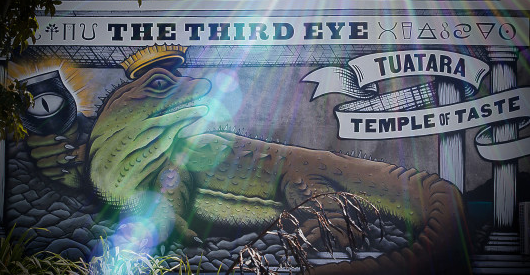How Wellington became the home of craft beer – talking brews and Beervana with Tuatara’s Third Eye manager Scott Boswell

Boswell is something of an old hand in the Wellington craft beer scene. He started working at the Malthouse in 2001, and also managed at The Hop Garden before joining the Tuatara team, where he is now the manager of the Third Eye, its craft beer bar complete with an in-house microbrewery.
Its bar, located on Arthur St in Te Aro, acts as a tasting room, as well as a testing ground for some of the more experimental flavours Boswell and the Tuatara team tinker with.
About one to two new flavours are created on-site each month, and if they do well, they have the chance to be rolled out to Tuatara’s bigger brewery in Kapiti.
Previous concoctions include a crab pale ale made with real crabs (an even “crabbier” version will be available at Beervana) and a brown ale with goose stock folded into it, though neither beverage made it into being a permanent product.

Tuatara founder Carl Vasta and Scott Boswell
Over the past 16 years, Boswell has seen the craft beer scene in the capital take shape, diversifying from a couple of big players into a mecca for breweries, big and small.
He says Wellington “accidentally” became the home of craft beer in the same way Wellingtonians rallied behind the local coffee culture when it was a new phenomenon.
“It’s a goldilocks kind of zone – a city that’s small enough by being geographically smushed in together all living, working and playing in the same area, so it doesn’t take much for a spark to take hold,” Boswell says.
“Wellington as a city is really good for supporting those groundswell, local movements, whether it’s 42 Below vodka being distilled in a guy’s garage or Pic’s Peanut Butter dedicating three years to working out exactly what the best peanut is to import to make good peanut butter – I don’t know how much support those kinds of industries would find in bigger cities.”
According to the 2017 ANZ Craft Beer Report, there are now 194 ‘craft’ breweries in the New Zealand market. A good chunk of these are in the Wellington region – 34, to be exact.
This is a leap in the number of breweries when compared to 2001, where New Zealand had 62 small and seven large breweries in operation.
Boswell says back when he began in the industry around 16 years ago, the diversity of beer styles was also limited, with only five or so recognised.
“What craft looks to do is to fill in all the grey scale in between,” Boswell says. “Craft is all about reinterpreting, re-contextualising a beer. You want to put your own stamp on it and that’s one of things Tuatara has done over the years – moved away from faithfully recreated beers and doing it with more of a New Zealand edge on it, using locally grown hops and locally grown malts.”
He says a craft brewer is like a chef in many respects.
“I wouldn’t expect a chef to go ‘all the food in the history of mankind has already been created’. There’s always that drive to experiment and the artistry coming through, we’re still creating stuff as opposed to automatism that spits some beer out at the other end.”
There are now 152 variations of beer listed in the Brewers Association Beer Style Guidelines.
Another aspect that’s changed is that in the early days is the need to explain what each flavour of craft beer was. Boswell said it was perfectly acceptable to call your beer a pilsner or an IPA in the branding, because the concept was very new to people.
Now, a lot of people – although he reckons Wellingtonians in particular lead the charge on this one – have a higher level of education around craft beer, while the market has become more saturated, leading to brands like Tuatara undergoing brand refreshes to relabel their core range.

Exactly what craft beer means is still a matter up for debate, Boswell says.
“No one can really agree on what craft means and that’s not without its problems as well. In the US and Australia, the craft beer industry has ditched the idea of craft and moved towards the idea of independents being the most important aspect of what they’re talking about,” he says.
“Craft means something to you, to me, to Joe Bloggs on the street. Independent ownership is defining characteristic of what craft beer is all about, so it’ll be interesting to see whether New Zealand adopts that. In our context under DB [DB bought Tuatara for an undisclosed sum in January 2017] I’d define that down even further and say you can still have independence of spirit, even if you don’t physically own the copper and the bricks and mortar, ownership is not actually that relevant, as long as you’re still in charge of your own destiny and still brewing the beers the way you want to brew them.”
At Beervana this year, Tuatara will be showcasing new beers in six different flavour profiles, such as sweet, sour, bitter and bready. Other new brews include a sweet chocolate milk stout and a feijoa mandarin flavoured beer.
The interesting (and apparently very palatable) crab pale ale will also make another appearance.
“They’re all beers designed to be drunk, though maybe some are more readily drinkable than others,” Boswell says.




